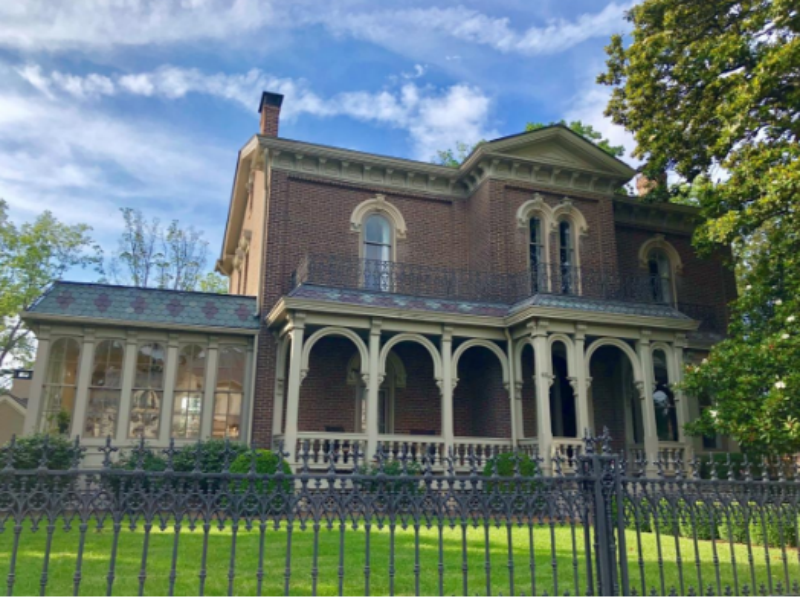Intro | 1 | 2 | 3 | 4 | 5 | 6 | 7 | 8 |
8. Harris McEwen House (612 Fair Street)
ABOUT THE HARRIS MCEWEN HOUSE:
The Harris McEwen House was home to Franklin’s mayor during the Civil War and served as a makeshift hospital after the bloody Battle of Franklin. The house began as a one-story structure, built in the early 1830s by Carey Allen Harris (who married Martha Fontaine, the daughter of Franklin’s founder Abram Maury, Jr.). When Carey died in 1842, John Brown McEwen, a successful businessman and lawyer, purchased the eleven-acre property and moved in with his wife Cynthia Graham McEwen and their five children. The McEwens added an Italianate style front, while incorporating the original house into the rear portion. During the Battle of Franklin, the McEwen family and their servants took shelter in the cellar and later opened their home to wounded Union and Confederate soldiers.
The McEwen family lived in the house for almost 90 years. When Mel and Cheryl Thompson bought the 6,500-square-foot home, they undertook a meticulous, three-year restoration, which included cutting the exterior mortar and cleaning every brick. The project earned them an award for residential rehabilitation from the Heritage Foundation of Franklin and Williamson County. The current owners are J. Michael Bodnar, a founding partner of Fresh Hospitality (an investment company that has partnered with numerous restaurants, including Biscuit Love, Jim ‘N Nick’s Bar-B-Q, and Taziki’s), and his wife Ann Bodnar.
WHY I LOVE THIS HOUSE:
I was immediately drawn to the Harris McEwen House’s arched porch and sun-bathed conservatory, but the home’s list of fascinating owners appealed to me even more. Carey Harris, the builder of the original one-story house, published his own newspaper called “The Independent Gazette” when he was 15. He went on to become chief clerk of the War Department in Washington at age 28 and served under President Jackson as the acting Secretary of War for 21 days.
As previously mentioned, the next owner, John B. McEwen, holds a special place in Franklin’s history as mayor during the town’s most perilous period—the Civil War. As the occupation period began, he surrendered Franklin to the Union Army in hopes of mitigating loss of life and property. After the Battle of Franklin on November 30, 1864, the whole McEwen family pitched in to care for the wounded that filled their home. The McEwens continued to nurse an injured Confederate surgeon, Dr. Sloan, in their house until he died in June 1865. They buried him in the McEwen plot in Rest Haven Cemetery. Now that’s a legacy to be proud of.
SOURCES:
- Bowman, Virginia McDaniel. Historic Williamson County: Old Homes and Sites. Blue & Gray Press, 1971. Print.
- Campbell, John F. “The Campbells of Drumaboden (1925).” Williamson County Historical
Society Journal, no. 12, 2011, pp. 1-54. - Crutchfield, James A. A Heritage of Grandeur. Carnton, Association, Inc., 1981. Print.
—Historic Franklin Tennessee. Grandin Hood Publishers, 2009. Print.
“Franklin Historic Homes Folder.” Williamson County Public Library Special Collections.
Historic Downtown Franklin Walking Tour Map. Williamson County Convention & Visitors
Bureau.
“Our Story.” Heritage Foundation Williamson County, TN,
www.williamsonheritage.org/ourstory/. Accessed 11 June 2018. - Warwick, Rick. Historical Markers of Williamson County, Tennessee: A Pictorial Guide.
Hillsboro Press, 1999. Print.
—“The National Bank of Franklin (1871-1926).” Williamson County Historical Society Journal, no. 49, 2017-2018, pp. 111-128.
—Personal interview. 6 June 2018.
—Wish You Were Here, A Postcard Tour Of Franklin and Williamson County. Panacea Press,2007. Print.



















